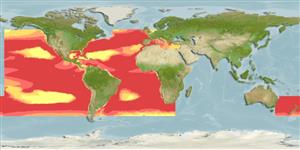Environment: milieu / climate zone / depth range / distribution range
पारिस्थितिकी
समुद्री बैथीपिलाजिक. Deep-water; 55°N - 49°S, 180°W - 180°E
Probably worldwide in tropical and subtropical seas. Eastern Atlantic: southern Ireland, scattered records in western Mediterranean, also Madeira Islands. Western Atlantic: Gulf of Mexico (Ref. 27768). Western Pacific: Australia (Ref. 7300) and New Zealand (Ref. 5755).
आकार / वज़न / Age
Maturity: Lm ? range ? - ? cm
Max length : 21.0 cm TL पुल्लिंग / अलिंग; (Ref. 3978)
पृष्ठीय रीढ़ (सम्पूर्ण): 0; पृष्ठीय सौफट रेज़ (सम्पूर्ण): 10-12; गुदा कांटा 0; ऐनल सौफट रेज़: 7 - 9; जानवरों की रीड़ का जोड़: 44 - 45. Body silvery, darker near tail (Ref. 3978). Swim bladder faintly colored. Adults mostly silver (Ref. 37473).
Mesopelagic species (Ref. 3978, 58302). Generally solitary. Probably feeds on zooplankton. Spawns throughout the year in the Mediterranean, more in winter.
Life cycle and mating behavior
परिपक्व अवधि | पुनरुत्पत्ति | मछलीऔ का अंडे देना | अंडे | Fecundity | लार्वा
Cohen, D.M., 1984. Argentinidae (including Microstomatidae). p. 386-391. In P.J.P. Whitehead, M.-L. Bauchot, J.-C. Hureau, J. Nielsen and E. Tortonese (eds.) Fishes of the north-eastern Atlantic and the Mediterranean, Volume 1. Unesco, Paris. (Ref. 4773)
IUCN Red List Status (Ref. 130435)
Threat to humans
Harmless
Human uses
मात्स्यिकी: कोई रुचि बग़ैर
अधिक जानकारी
आम नामउपशब्दचपायचयपरभक्षीईकोटोकसीकोलौजीपुनरुत्पत्तिपरिपक्व अवधिमछलीऔ का अंडे देनाSpawning aggregationFecundityअंडेEgg development
संदर्भजलीयकृषिजलीयकृषि रूपरेखाखींचआनुवंशिकीElectrophoresesहैरेटिबिलटीबीमारीप्रक्रमणNutrientsMass conversion
सहयोगीयोतस्वीरेStamps, Coins Misc.ध्वनिसिगुयटिरारफ्तारतैरने के प्रकारगिल क्षेत्रOtolithsदिमागदृष्टि
साधन
Special reports
Download XML
इंटरनेट स्रोत
Estimates based on models
Preferred temperature (Ref.
123201): 8.8 - 19.6, mean 13.4 °C (based on 608 cells).
Phylogenetic diversity index (Ref.
82804): PD
50 = 1.0000 [Uniqueness, from 0.5 = low to 2.0 = high].
Bayesian length-weight: a=0.00389 (0.00180 - 0.00842), b=3.12 (2.94 - 3.30), in cm total length, based on all LWR estimates for this body shape (Ref.
93245).
Trophic level (Ref.
69278): 3.4 ±0.45 se; based on food items.
Fishing Vulnerability (Ref.
59153): Low vulnerability (11 of 100).
